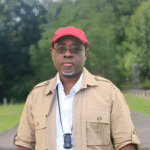
Learning in the Open: Vivian Ayers Allen and the Freedom of the Field
By: Sharon L. Sanders
Before “From Fields to Feeds” became a digital movement to restore agricultural wisdom and Black land ownership, there was another vision crafted by a poet, educator, and cultural oracle whose brilliance was rooted not just in language, but in land.
Vivian Ayers Allen, literary legend and intellectual matriarch, taught us that the field so often symbolizing toil and trauma for Black Americans could also be reclaimed as a site of liberation, imagination, and rebirth. Through her groundbreaking program Workshops in Open Fields, she planted a bold idea: that education, to be transformational, must happen in spaces where the mind and body are free. Her legacy lives in the soil and in the soul of the work we now carry forward. From Fields to Feeds is not simply a project about farming. It is a declaration that our land, our knowledge, and our stories are worth preserving and that technology is the new terrain where that preservation must now occur.
In honoring the memory and enduring wisdom of Ms. Vivian, who has now joined the ancestors, I find it fitting to reflect on the powerful parallels between her visionary Workshops in Open Fields and our own contemporary movement. What follows is not just a comparison, but a tribute to her legacy and the pathways she cleared for us all:
1. Reclaiming the Field as a Place of Empowerment
For Ayers Allen, the field was no longer a symbol of oppression; it was a space of reimagination. Children learned in the open air, moving through poetry, dance, and cultural expression. Education took place not within confined walls, but in liberated landscapes.
Today, From Fields to Feeds reclaims the field by reconnecting Black communities to farming, land stewardship, and agricultural sovereignty. What was once taken from us is now being re-rooted digitally, culturally, and strategically.
Parallel: Both turn the field into a site of transformation from forced labor to freedom, from survival to strategy.
2. Education Rooted in Cultural Reconnection
Workshops in Open Fields taught children to engage with learning through language, rhythm, movement, and heritage. It wasn’t about memorization. It was about remembering who we are, where we come from, and how our ancestors lived, thought, and created.
Likewise, From Fields to Feeds educates through reconnection. We tell stories of land loss and land legacy. We teach techniques for urban gardening and rural revival. And we do it with a cultural consciousness that honors those who tilled the soil before us.
Parallel: Both see education not just as a transfer of knowledge, but as a restoration of identity.
3. Modernizing Traditional Knowledge
Ayers Allen was decades ahead of her time. She envisioned schooling rooted in the cosmos, African cosmology, and multilingual exploration. She blended poetry with planetary thinking, ancient knowledge with modern insight.
In our digital age, From Fields to Feeds uses tech to broadcast ancestral wisdom. We translate old farming techniques into new media. We merge sustainability with storytelling. Instagram becomes a journal. TikTok becomes a classroom. Blogs become blueprints for survival.
Parallel: Both movements embrace innovation to preserve heritage, remixing the past for a future that belongs to us.
4. Black Sovereignty: Mental, Cultural, and Economic
Vivian Ayers Allen believed literacy was liberation. Her workshops weren’t just about art; they were about agency. They taught young people to think critically, move freely, and imagine abundantly.
From Fields to Feeds shares that spirit. We aim to empower through land—because land is not just property, it’s power. We highlight the importance of agriculture, Black land ownership, and heirs property preservation, amplifying the stories of those still rooted in the land and living its legacy.
Parallel: Both efforts define liberation as something multi-dimensional: owning your mind, your culture, and your future.
A Living Tribute
From Fields to Feeds stands as a digital descendant of Workshops in Open Fields. Vivian Ayers Allen taught us that art, language, and soil were all part of the same liberation practice. The field was her classroom, her canvas, her sanctuary — a place where the mind could stretch, the body could move, and the spirit could remember.
As we cultivate this work—both on land and online—we do so in reverence for what the field can still teach us. In an age of screens and scrolls, we are reminded that knowledge rooted in nature, in space, in movement, and in story still holds power. Her vision gave us wings. Her wisdom gave us grounding.
She taught us to soar — and to listen to the earth beneath our feet.
Now, the field is ours.


